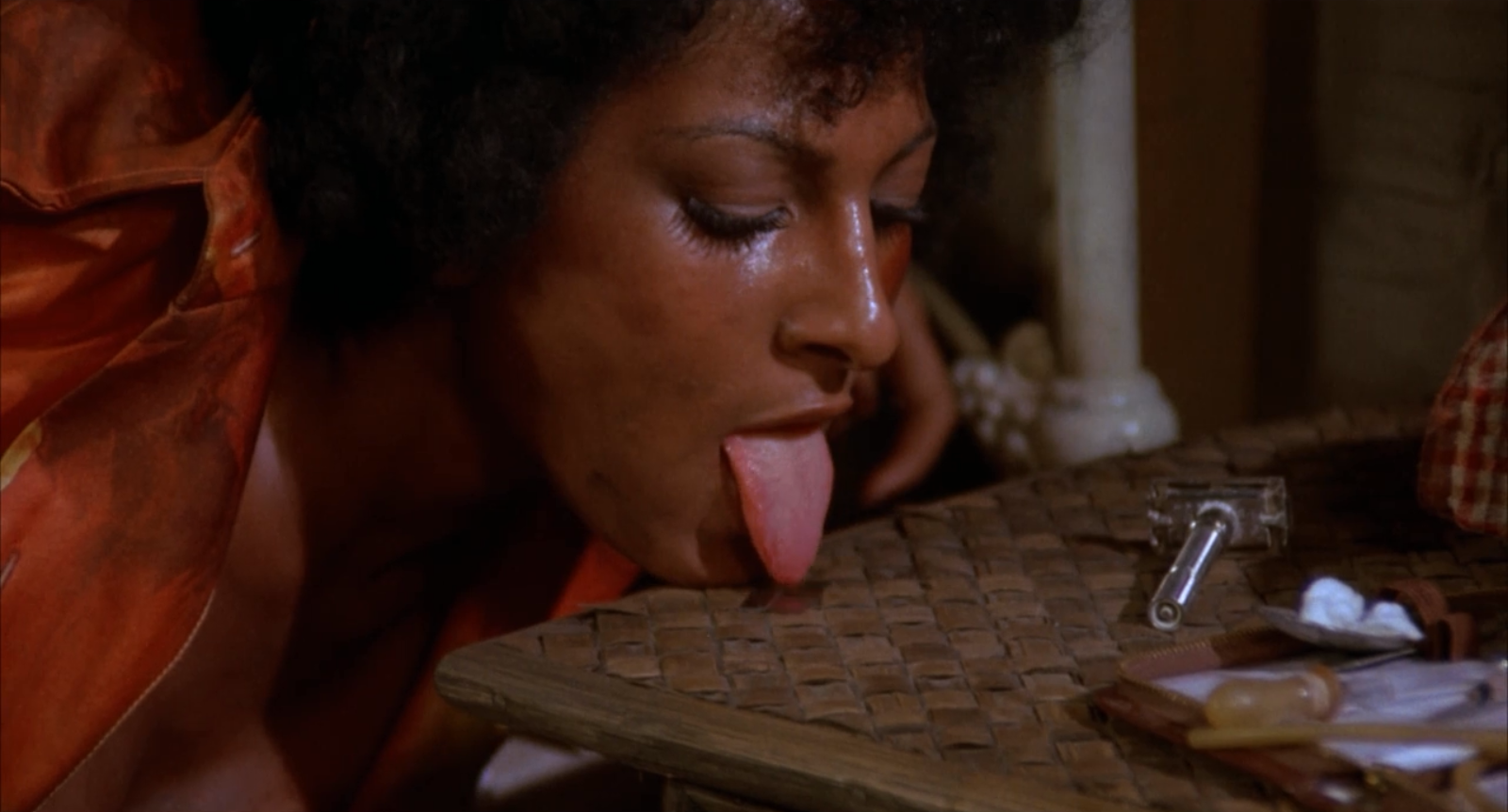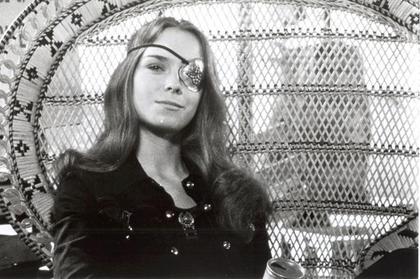Foxy Brown acquires a razor on her way to her revenge.
Jack Hill loved to interpolate other exploitation genres in his exploitation films. So while the 1974 blaxploitation classic Foxy Brown isn’t exactly a rape/revenge, it does have a rape/revenge set piece tucked away in the middle. Foxy Brown (Pam Grier) is caught by the evil drug pushers, and sent out to the Ranch. There, two beefy, chuckling white trash hillbillies hook her on heroin and rape her repeatedly—until (of course) she frees herself and inflicts a terrible revenge involving coat hangers, gasoline, and charred corpses.
Hill’s rape/revenge riff — like many a rape/revenge riff—is indebted to deliverance. The white trash rapists in the context of a blaxploitation film take on additional relevance, as they spit racial epithets and even use a whip on Foxy, nodding to slavery and the history of sexual violence against black women. In Deliverance, poor whites are presented as a debased, violent, but also victimized racial other, locked in conflict with effete urban gentrifiers. Foxy Brown deliberately reminds viewers that rural whites and urban whites aren’t always at each other throats, but have often made common cause against people who look like Pam Grier.
The Deliverance reference isn’t just about race, though. It’s also about gender. In Men, Women, and Chainsaws, Carol Clover points out that the male rape in Deliverance serves as a prototype for many of the female rapes in exploitation cinema. That means that male viewers are not (or not just) supposed to identify with the male rapists; they’re supposed to identify (as they do in Deliverance) with the person being raped. In Foxy Brown, the imagined viewer is certainly mainly black. The Deliverance reference inscribes that viewer as not just black women, but black men as well, both of whom are encouraged to identify with Foxy as she is violated, and then takes violent revenge.
There are other indications in the film that rape in the film is about violation of black men, as well as violation of black women. In particular, the fate of the lead dope pusher Steve (Peter Brown) at the conclusion of the film is a collaborative male/female endeavor. Foxy allies herself with a black anti-drug, neighborhood watch coalition, and together they kill Steve’s bodyguards and capture Steve himself. The men hold Steve, and pull off his pants. Then they look to Foxy for the final order, and their leader castrates him. Finally, Foxy puts his genitals in a pickle jar and takes them to show his girlfriend, the evil Kathleen Wall (Kathryn Loder). Rape/revenge stereotypically uses castration as the recompense for rape—but in this case, that castration functions both as revenge for the sexual violence against Foxy, and as revenge for the way the heroin dealers have exploited the black community as a whole (and black men in particular.)
Even though the rape/revenge sequence only takes up 10-15 minutes in a 90 minute film, then, it is structurally and thematically central. First, it presents heroin pushing and sexual violence as parallel crimes, both used by white men (and white women) to humiliate and torture black people. Second, in doing so, and through the reference to Deliverance, it solidifies Foxy Brown’s position as a point of identification for black men as well as black women, both in her rape and in her revenge.
As Claire Henry points out, Foxy Brown, and other blaxploitation films, often aren’t included as part of the rape/revenge canon. Henry argues that this is because white society (and white critics) do not see black women’s rapes as important, or worthy of attention. Stephane Dunn notes, though, that the rape/revenge in Foxy Brown is in many ways downplayed; Foxy shows no ill-effects from sexual violence, nor for that matter from her forced heroin injections. Rape serves as a metaphor for white violence against blacks, but the specificity of the individual trauma of rape is lost — as well as the specificity of the historical sexual violence unleashed against black women.
The rape/revenge genre, then, focuses on white women, and has trouble thinking about the intersection of race and rape. Blaxploitation focuses on racial exploitation — and has trouble thinking about the intersection of race and rape. Foxy Brown doesn’t so much resolve the dialectic as illustrate it. Hill includes a rape/revenge skit in the middle of a blaxploitation revenge feature, and showing how the two parallel each other, but never, quite, manages to bring the two together into a whole that honors and sympathizes with black women’s historical, and ongoing, experience of sexual violence.
_____
One possible exception to the above is Talia Lugacy’s The Descent (2007). One of the few rape/revenge films with a female director, it also is unusual in featuring a woman of color; Rosario Dawson plays Maya, the lead.
As often happens with rape/revenge films, The Descent gets a worse rep than it deserves. This critic for example attacks it in part because he doesn’t understand why she refuses to go to the police (maybe women of color don’t share your faith in the cops, maybe?) and because the rape scene is insufficiently explicit (how can we care about sexual violence unless it’s really spectacular and gross?)
But while The Descent isn’t a disaster, it can’t be said to be a success, either. The film does confront race head on. Jared, the rapist football player jerk, uses racist insults as he date rapes Maya. More, his frat-boy persona and indeed the whole college milieu is figured as white; the best part of the film is the way that it functions as a kind of sickening send up of Dead Poets Society and the typical John Hughes rom com. Jared brags about seizing the day and takes Maya out to see the stars and keeps pushing at her and pushing at her boundaries, just the way you’re supposed to do, and isn’t that cute that he’s such a swoony deep romantic John Cusack lead— and then, whoops, it turns out that swoony deep romantic lead is in fact an awful priviliged racist raping shit.
The revenge part of the film seems to have racial overtones as well, though the handling of them is less sure. In reaction to the rape, Maya starts to take risks; she frequents a club where the clientele is black, Hispanic, and queer. Mya’s non-white identity becomes a kind of alternative to the square, college life with its hypocrisy and violence.
The solidarity in the face of oppression is never expressed unambituously as it is in Foxy Brown, though; instead of framing resistance to white supremacy as politics, it ends up being presented as titillating lifestyle choice, complete with BDSM games and foot fetishism. It’s not clear, either, what we’re to make of Maya in this setting. Has the rape degraded her and damaged her by pushing her into this more interracial milieu? Has the rape opened her up to sexual and communal possibilities (as she suggests at the end)? Neither of these seems like a very thoughtful takeaway, and, perhaps realizing as much, the film vacillates between them in confusion. As in Foxy Brown, rape/revenge doesn’t seem quite able to tie together its themes of sexual and racial violence. In these films not all women are white, and not all men are black, but while women of color exist, at least as far as rape/revenge has managed so far, their outlines remain blurry.


